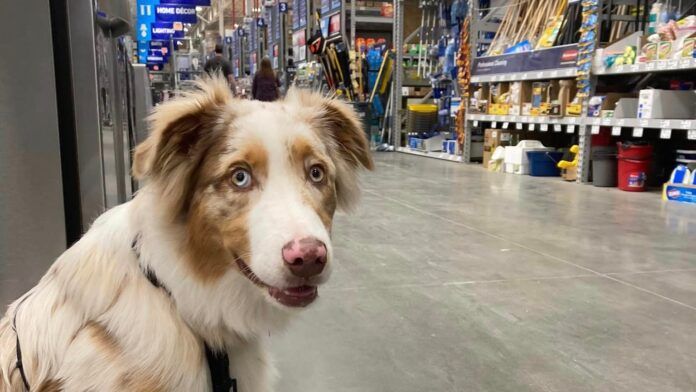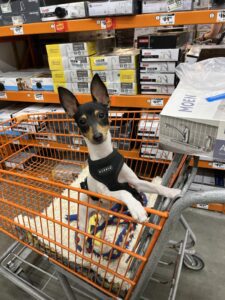
In many parts of the world, dogs are welcome everywhere; all stores are dog friendly! That isn’t the case in the United States, but a surprising number of American businesses open to the public are also open to the public’s pet dogs.
Retail stores can be terrific training areas for puppies and adult dogs, offering interesting distractions and friendly greetings in small, cozy shops or industrial warehouses.
Where can you bring your dog?
Most pet supply stores welcome well-behaved dogs. You can count on access for friendly dogs at the large chain pet supply stores, such as
- Petco
- Petsmart
- Pet Supplies Plus
- Pet Valu (Canada)
- Pet Supermarket
- Farming or ranching supply stores, and similar locations.
The national hardware or home-improvement chain stores are similarly friendly to dogs. Bring your canine companion to:
Pet-welcoming sporting goods stores include:
Some department and clothing stores welcome dogs, including:
Keep in mind that even if a chain describes itself as pet-friendly, decisions about canine visitors can vary by location, and store managers make final decisions about their stores’ pet policies. Also, some pet-friendly stores are located in shopping malls whose pet policies are different from those of its individual stores, so don’t assume that you and your dog will be welcome without verifying the situation first.
Depending on where you live, you may be surprised at the number and variety of stores, movie theaters, vineyards, art galleries, ballparks, craft and hobby shops, phone stores, and other establishments that welcome well-behaved dogs. Ask friends, dog trainers, and local pet supply stores for recommendations.
To find hotels, motels, and other overnight accommodations that welcome dogs, visit Bring Fido’s online directory BringFido: Pet Friendly Hotels & Dog Travel Directory , which includes dog-friendly restaurants, bars, cafes, coffee shops, and other establishments. If dogs are not allowed indoors at a restaurant, they may be accommodated in outdoor dining areas.

Follow the rules
Does the store have a pet policy? If so, be sure to follow it. Follow unposted commonsense rules, too, such as:
- Bring a healthy, clean, well-groomed dog.
- Use appropriate equipment, such as a short, strong leash (no retractable leashes!) and an appropriate collar or harness.
- Carry pick-up bags and cleaning wipes.
- Bring one dog at a time. It’s impossible to manage two or three dogs in unpredictable situations, and that’s exactly what shopping visits can be.
Service dogs have privileges that pet dogs don’t, and it’s never OK to pretend that your dog is a service dog if that isn’t the case. The Americans with Disabilities Act (ADA) defines service dogs as dogs who are “individually trained to do work or perform tasks for an individual with a disability.” That definition does not include emotional support dogs, therapy dogs, or companion animals, so respect signs that say “Service animals only.”
Tips For a Smooth Visit With Your Dog
Taking our dogs into busy retail establishments shouldn’t be attempted casually or without preparation. Keeping your dog calm and comfortable and ensuring the comfort and safety of your fellow shoppers requires time, effort, and attention to detail. Employ these tips to ensure an uneventful visit:
- Scout the location ahead of time. Is the site really appropriate for your dog? Visit the store for the first time without your dog to see whether the location is a good match to your dog’s personality and training. If it isn’t, look elsewhere.
- Avoid peak shopping hours. Even a well-matched shopping environment can be challenging if it’s noisy, crowded, or overwhelming for your pup. For your dog’s initial visit, avoid grand openings, special sales, rowdy celebrations, or peak attendance hours.
- Practice basic behaviors. Visiting dogs who know how to walk on a loose leash, sit, stay, and come when called are more likely to behave politely than dogs who don’t. Perfect your dog’s manners by practicing in unfamiliar environments until your dog is reliably polite in new settings and around strangers and other animals.
- Know why you’re going. Do you plan to shop for something? Will you consult salespeople? If so, don’t bring your dog unless he or she can lie quietly while you transact business. If a store trip is a training opportunity, focus on the interactions you want to encourage or improve, and anticipate the steps you’ll need to take for best results.
- Park where you can take your dog for a pre-shopping walk. Instead of going straight to the front door, take a stroll and give your dog time to explore, urinate, and defecate far from the entrance. Clean up after your dog and leave your pickup bag in a trash receptacle or in your car for later disposal.
- Enter the store calmly. Focus your dog’s attention on you, so you can arrive quietly, without causing a disturbance.
- Maintain control. Keep your dog next to you on a short leash, rewarding your dog with treats or other rewards that your dog responds to.
- Respect other dogs and people. Retail stores are not puppy playgrounds. Prevent your dog from approaching others without their consent. Study your dog’s body language and interrupt any behaviors that might harm children, other pets, or product displays.

- Pay attention. Inattentive handlers create problems by not noticing while their dogs chew, lick, bite, or urinate on merchandise, make threatening eye contact with other dogs, or jump on people. “He’s just being friendly” is not an acceptable excuse. If you’re not able to pay attention to your dog when you visit a store, practice until responsible handling skills become second nature.
- Minimize barking and other vocalizations. Polite visits are quiet, not noisy. Barking, growling, yipping, and other sound effects might be familiar and unthreatening to you, but they may annoy or frighten others. At their worst, noisy dogs are disruptive and can initiate physical confrontations.
- Know where you can and can’t take your dog. Most stores do not allow dogs in food service areas because of health code regulations, and some areas may be off-limits for other reasons. Pay attention to signs that define “no pets” areas.





